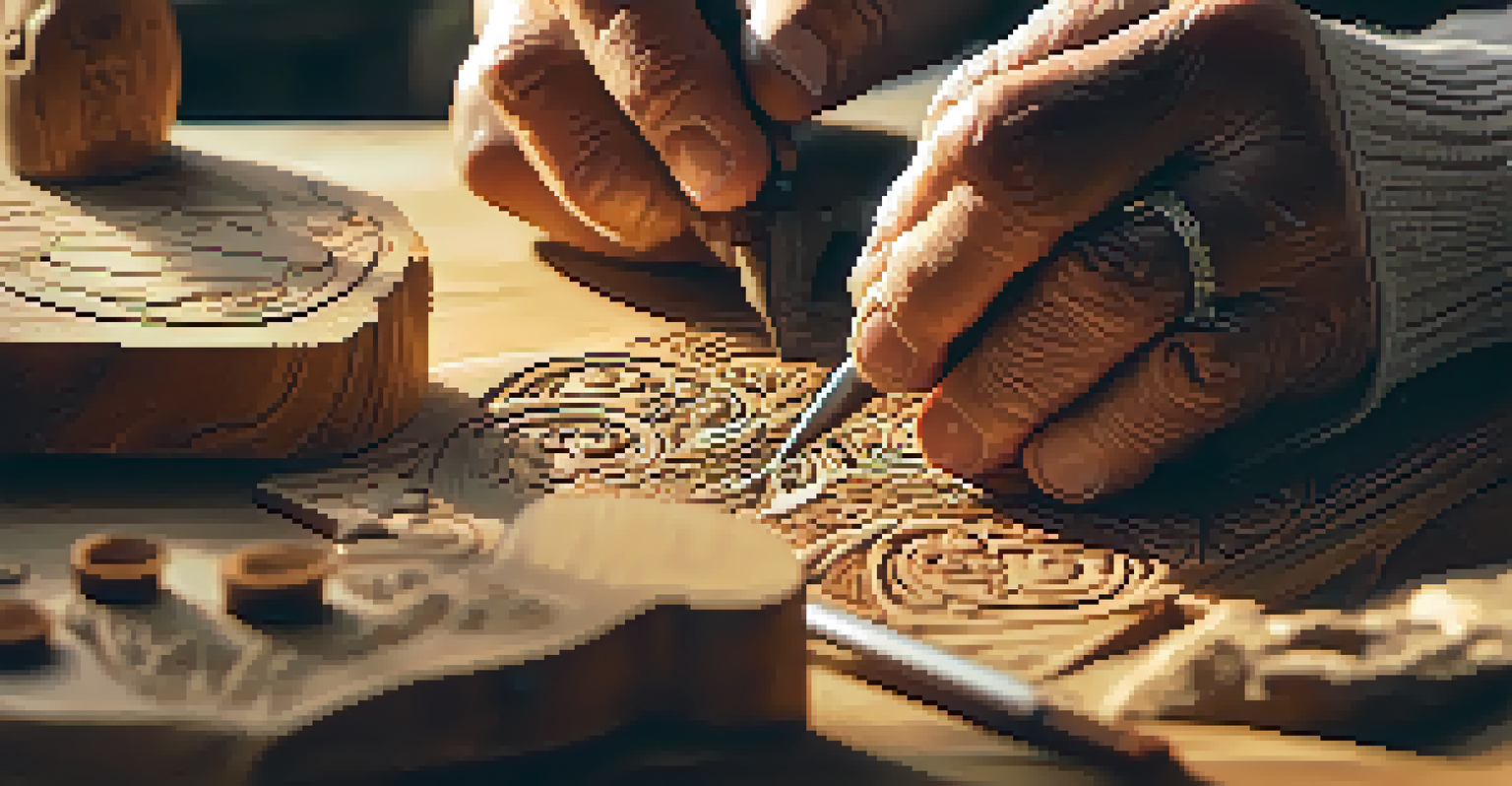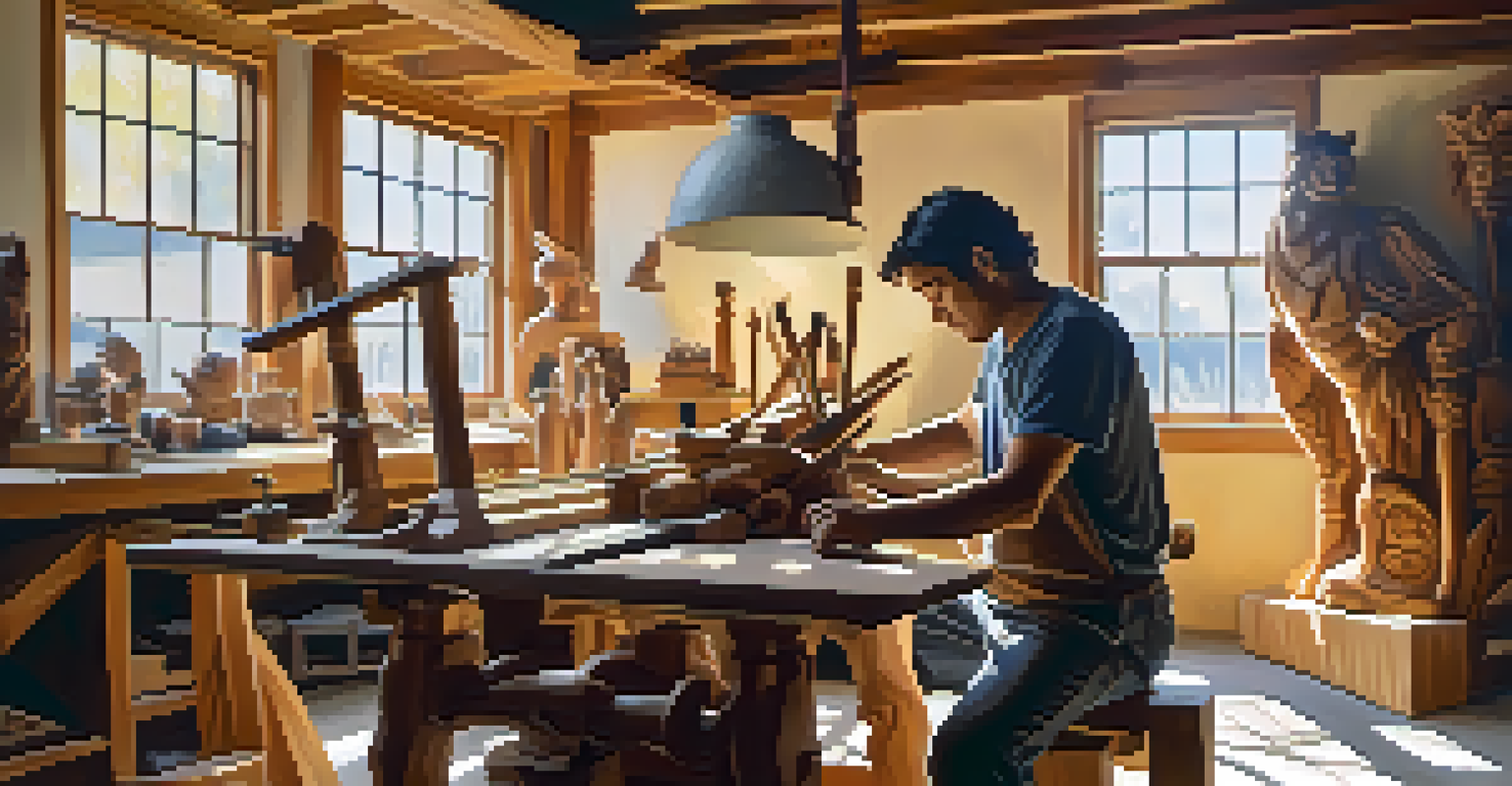The History and Evolution of Wood Carving Techniques

The Origins of Wood Carving: A Journey Through Time
Wood carving dates back to ancient civilizations, with evidence found in archaeological sites. Early artisans utilized simple tools to create functional items and decorative pieces, reflecting their culture and beliefs. As wood was readily available, it became a preferred medium for expressing artistry and utility.
Wood carving is a craft that allows the artist to unite the natural beauty of wood with their own creativity and skill.
From the carvings of ancient Egypt to the intricate designs of the Greeks, wood carving played a significant role in daily life and ritual. These early creations often depicted deities, animals, and everyday scenes, serving both aesthetic and religious purposes. This historical foundation set the stage for the evolution of techniques and styles that would follow.
The craftsmanship involved in these early carvings was not just about skill; it was also about storytelling. Each piece conveyed a narrative, connecting the creator with their community and the natural world. This deep-rooted connection remains a vital aspect of wood carving today, showcasing its enduring legacy.
Tools of the Trade: The Evolution of Carving Instruments
As wood carving developed, so did the tools used by artisans. Initially, primitive tools made from stone or bone were replaced by metal chisels and gouges, allowing for greater precision and detail. The introduction of these tools marked a turning point, enabling craftsmen to explore more complex designs and techniques.

In the Middle Ages, wood carving tools became more specialized. The emergence of different blade shapes and sizes allowed artisans to create intricate patterns and textures, enhancing the aesthetic appeal of their work. This period also saw the rise of guilds, where knowledge and techniques were shared and refined, fostering a rich culture of wood craftsmanship.
Wood Carving's Rich Cultural Legacy
Wood carving reflects the cultural identities and traditions of societies, showcasing their values through artistic expression.
Today, wood carvers have access to a variety of modern tools, including electric routers and CNC machines. While technology has transformed the landscape, traditional hand-carving techniques still hold a cherished place in the craft. Many artisans blend old and new methods, creating a dynamic fusion that pays homage to their roots.
Cultural Influences: How Traditions Shaped Wood Carving
Wood carving is deeply intertwined with cultural identity, reflecting the values and beliefs of different societies. In Asia, for example, intricate woodwork often showcases spiritual themes, while Indigenous cultures utilize carvings to tell stories of their ancestry and connection to the land. Each region developed unique styles, influenced by local resources and traditions.
The art of wood carving is a timeless expression of culture, history, and identity.
In Europe, the Renaissance period brought a surge of creativity in wood carving, where artists like Michelangelo elevated the craft to new heights. This era saw the incorporation of human figures and elaborate scenes, highlighting the interplay between art and architecture. These innovations not only advanced the technique but also established wood carving as a respected art form.
Modern wood carving continues to be influenced by cultural exchanges and globalization. Artists today draw inspiration from various traditions, blending techniques to create contemporary pieces that resonate with diverse audiences. This ongoing dialogue between cultures enriches the craft, ensuring that wood carving remains a vibrant and evolving art form.
Techniques Through Time: Traditional vs. Contemporary Methods
Traditional wood carving techniques, such as relief carving and chip carving, have stood the test of time. Relief carving involves creating a raised design on a flat surface, while chip carving focuses on removing small chips to create geometric patterns. These methods require a high level of skill and patience, reflecting the dedication of the artisan.
In contrast, contemporary wood carving often embraces innovation, using modern tools and approaches to push creative boundaries. Techniques like wood turning and sculptural carving have gained popularity, allowing artists to explore three-dimensional forms and abstract concepts. This blend of old and new highlights the versatility of wood as a medium.
Evolution of Carving Tools
The development of carving tools, from primitive to modern, has significantly enhanced the precision and creativity in wood carving.
Despite the differences, both traditional and contemporary methods share a fundamental goal: to express creativity and craftsmanship through wood. Many artisans today honor traditional techniques while experimenting with new ideas, resulting in a rich tapestry of styles that celebrate the history and evolution of wood carving.
The Role of Wood Types: Choosing the Right Material
The choice of wood is crucial in carving, as different types offer unique characteristics and aesthetics. Softwoods like pine and cedar are often preferred for beginners due to their ease of carving, while hardwoods like walnut and cherry provide durability and a rich grain. Each wood type influences the final outcome, allowing artisans to express their vision effectively.
Certain woods are also associated with specific cultural practices. For instance, mahogany is revered in many cultures for its deep color and fine grain, making it a popular choice for high-end furniture and decorative pieces. Understanding the properties of different woods can greatly enhance the quality and longevity of the finished work.
Moreover, sustainability has become a vital consideration in modern wood carving. Many artisans now seek ethically sourced and reclaimed woods, promoting environmental responsibility within the craft. This shift not only supports the planet but also adds a unique story to each piece, connecting the creator to a larger narrative of conservation.
Influential Wood Carvers: Pioneers of the Craft
Throughout history, there have been many influential wood carvers who have shaped the craft. Figures like Grinling Gibbons, an English sculptor of the 17th century, are celebrated for their intricate and lifelike carvings. Gibbons' work in churches and stately homes showcased the potential of wood as a medium for fine art, inspiring generations of artisans.
In more recent times, contemporary artists like David Esterly have made significant contributions to the field. Esterly is known for his remarkable restorations of historic wood carvings, blending traditional techniques with modern insights. His work not only preserves the past but also ignites interest in the craft among new audiences.
Sustainability in Wood Carving
Modern wood carvers increasingly prioritize sustainability by using ethically sourced materials, promoting environmental responsibility in their craft.
These pioneers remind us that wood carving is not just a skill but an evolving art form. Their legacies encourage aspiring artisans to explore their creativity and push the boundaries of what can be achieved with wood. The stories of these influential figures continue to inspire and enrich the world of wood carving.
The Future of Wood Carving: Trends and Innovations
As we look ahead, the future of wood carving appears bright, shaped by emerging trends and innovations. The integration of technology, such as laser cutting and 3D printing, is transforming how artists approach their work. These advancements open new avenues for creativity, allowing for more complex designs and faster production times.
Additionally, there is a growing movement toward sustainability within the craft. Many wood carvers are prioritizing eco-friendly practices, using reclaimed materials and promoting responsible sourcing. This shift not only benefits the environment but also resonates with consumers who value ethical craftsmanship.

Ultimately, the future of wood carving will likely be a harmonious blend of tradition and innovation. As artisans continue to draw inspiration from the past while embracing new techniques, the craft will evolve, ensuring that wood carving remains a vibrant and relevant form of artistic expression.